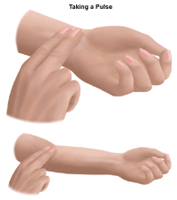Living With a Pacemaker
With advances in technology, pacemakers today generally last eight to ten years (depending upon the type of heart condition) and, in most cases, allow a person to lead a normal life. In addition, advances in pacemaker circuitry have reduced the interference risk from certain machinery, such as microwaves, which, in the past, may have altered or otherwise affected the pacemaker. Even so, certain precautions must be taken into consideration when a person has a pacemaker.
In the past, people with pacemakers risked interference with the proper functioning of their pacemakers if they were too close to car distributors, radar, microwaves, electric blankets, and airport security detectors. However, with improvements in pacemaker technology, this type of interference is less common.
The following precautions should always be considered. Discuss the following in detail with your physician:
- Use caution when going through airport security detectors. Check with your physician about the safety of going through such detectors with your particular pacemaker.
- Avoid magnetic resonance imaging (MRI) machines or other large magnetic fields.
- Abstain from diathermy (the use of heat in physical therapy to treat muscles).
- Turn off large motors, such as cars or boats, when working on them (they may temporarily "confuse" your pacemaker's rate).
- Avoid certain high-voltage or radar machinery, such as radio or television transmitters, electric arc welders, high-tension wires, radar installations, or smelting furnaces.
- If you are having a surgical procedure performed by a surgeon or dentist, tell your surgeon or dentist that you have a pacemaker, so that electrocautery will not be used to control bleeding (the electrocautery device can change the pacemaker settings).
- Always carry an ID card that states you are wearing a pacemaker.
- You may have to take antibiotic medication before any medically invasive procedure to prevent infections that may affect the pacemaker.
Always consult your physician if you have any questions concerning the use of certain equipment near your pacemaker.
Once the pacemaker has been implanted, people with pacemakers should be able to do the same activities everyone else in their age group is doing. When you have a pacemaker, you may still be able do the following:
- exercise moderately, upon advice from your physician
- drive your car or travel
- return to work
- work in the yard or house
- participate in sports and other recreational activities
- take showers and baths
- continue sexual relationships
When involved in a physical, recreational, or sporting activity, a person with a pacemaker should avoid receiving a blow to the skin over the pacemaker. A blow to the chest near the pacemaker can affect its functioning. If you do receive a blow to that area, see your physician.
Always consult your physician when you feel ill after an activity, or when you have questions about beginning a new activity.
Although your pacemaker is built to last several years, always check your pacemaker regularly to ensure that it is working properly. The proper method for checking the accuracy of your pacemaker includes the following:
- Take your pulse regularly to make sure your pacemaker is keeping your pulse at the targeted rate.
- Check your "pacing lead" (the lead which sends information from the heart to the pacemaker) with an electrocardiogram (ECG) at your physician's office. In addition, you may participate in a telephonic check up for your pacemaker on a periodic basis. Your physician will provide special instructions.
- See your physician regularly for check-ups.
- Report any unusual symptoms or symptoms similar to those you had prior to the pacemaker insertion to your physician immediately.
Always consult your physician for more information, if needed.
The pulse rate is a measurement of the heart rate, or the number of times the heart beats per minute. As the heart pushes blood through the arteries, the arteries expand and contract with the flow of the blood. Taking a pulse not only measures the heart rate, but also can indicate:
- heart rhythm (abnormal rhythm may indicate a heart disorder)
- strength of the pulse (a weak pulse may indicate a fast heart beat in which some beats are too weak to feel, heart failure, or a low volume of blood in the circulatory system)
 Click Image to Enlarge
Click Image to EnlargeThe normal pulse rate for healthy adults ranges from 60 to 100 beats per minute. The pulse rate may fluctuate and increase with exercise, illness, injury, and emotions. Girls ages 12 and older and women, in general, tend to have faster heart rates than do boys and men. Athletes, such as runners, who do a lot of cardiovascular conditioning may have heart rates in the 40's and experience no problems.
As the heart forces blood through the arteries, you feel the beats by firmly pressing on the arteries, which are located close to the surface of the skin at certain points of the body. The pulse can be found on the side of the lower neck, on the inside of the elbow, or at the wrist. When taking your pulse:
- Using the first and second fingertips, press firmly but gently on the arteries until you feel a pulse.
- Begin counting the pulse when the clock's second hand is on the 12.
- Count your pulse for 60 seconds (or for 15 seconds and then multiply by four to calculate beats per minute).
- When counting, do not watch the clock continuously, but concentrate on the beats of the pulse.
- If unsure about your results, ask another person to count for you.
If your physician has ordered you to check your own pulse and you are having difficulty finding it, consult your physician for additional instruction.
Click here to view the
Online Resources of Heart Center
|